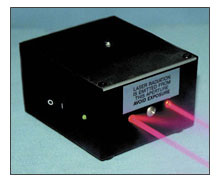KENNEDY SPACE CENTER, Fla., March 1, 2006 -- NASA's new photographic laser device was designed to assess damage to the space shuttle, but its creators are finding the device has other practical applications, such as providing more details in crime scene photographs for investigators.
Engineers at NASA's Kennedy Space Center developed the Laser Scaling and Measurement Device for Photographic Images (LSMDPI) to assist scientists who were unable to determine the exact scale of hailstorm damage to the space shuttle’s external tank simply by looking at photos of the spacecraft on its launch pad. 
NASA's laser scaling device attaches directly to a camera and projects a pattern of dots into the field of view. This pattern appears in the photograph along with the image of the object under investigation, enabling the viewer to measure the size of the object. Designed for the space shuttle, the device is also finding practical applications in crime scene investigation, oil tank monitoring and aerial photography. (Photo: NASA)
The LSMDPI is a half-pound black box, powered by a single nickel-cadmium battery that attaches directly to a camera’s tripod mount. Twin lasers an inch apart shoot from the box and add scale, allowing a person to look at these special photographs and have a better understanding of just how big or small the objects pictured really are. In the case of the space shuttle, engineers are now able to measure the distance from one part of the shuttle to a dent from a hailstorm to determine the extent of the damage.
Typically, when you use a camera to zoom in on an object, you lose track of the scale that tells you the object's actual size. When a picture is taken with the LSMDPI, the image loads into software designed by NASA electrical design engineer Kim Ballard. The user chooses a set of reference points, such as a laser pattern of reference point dots, that will appear along with the image of the target object. The user also inputs the distance between the reference points. The software then sets the scale based on that distance. This allows the viewer quantifiable perspective on the size of the object. The size of the object’s features can then be found and measured by using the computer software to mark the laser points.
Contractor Jeffrey Kohler of ASRC Aerospace, a company that supports NASA's Innovative Partnership Office, and his colleagues did an assessment to review the technology and how it could apply to potential commercial markets. “Forensics was at the top of the list,” said Kohler.
Today's crime investigations often rely on the device to scale evidence since its unique laser beams allow viewers to see image components much more clearly than traditional camera images, according to NASA. Not only can investigators use it to fully view photos of components from crime scenes such as blood-spatter patterns and graffiti, but they can also look at the images diagonally, horizontally and vertically to better analyze and understand the scenes. It is also becoming increasingly popular in crime laboratories around the world, and similar technology is being used for oil and chemical tank monitoring and aerial photography.
“I think that the greatest contribution that the laser scaling measurement software offers to law enforcement is it ‘uncuffs’ the investigator's hands with digital image evidence by facilitating fast and accurate measurement analysis of anything in a crime scene photo, not just the intended target,” said Ballard. “This aspect opens up the possibility for serendipitous evidence detection after the fact that may not have been obvious at the crime scene. For example, the software may be instrumental in attaining dimensions of articles or their proximity locations within a room that were not previously part of the investigation.”
Recently Ballard was asked by the FBI to add more capabilities to the software to enable forensics experts to zoom in and out of the image to measure blood-spatter details across a wall as well as specific areas, and also to broaden the range of usable image file types, which was previously limited to JPEGs. Following a recent request from the device's manufacturer, Armor Holdings Inc. of Jacksonville, Fla., NASA also included English/metric units to support European customers in areas such as surveillance and aerial photography.
For more information, visit: www.nasa.gov